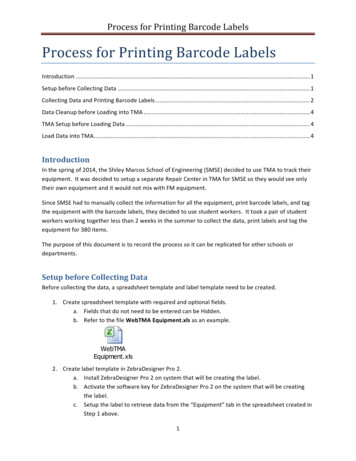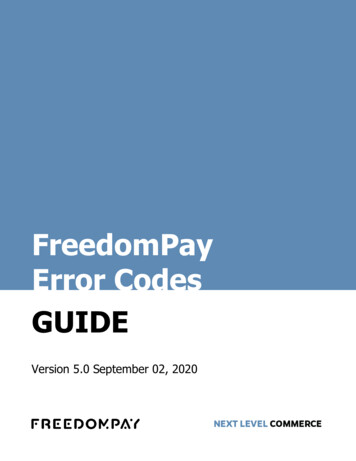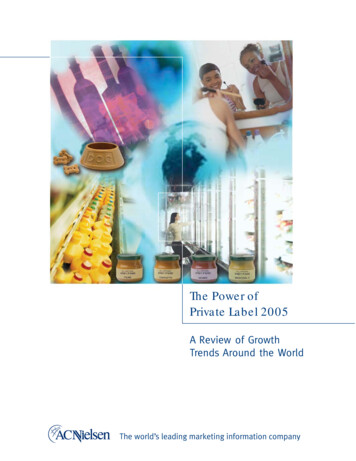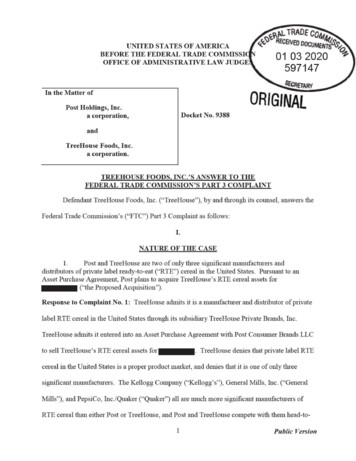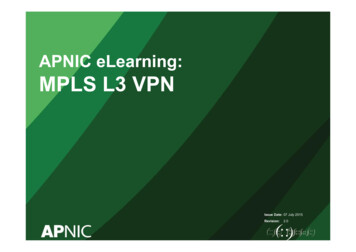
Transcription
SEA CHANGE FOR PRIVATE LABELPrivate Label has traditionallyresponded much like the ebb andflow of the tides. Its strength hasvaried with economic conditions; itbenefits when the economy is in arecession and suffers during periodsof economic growth.NEWPrivate LabelTrendPrivate Label share today in CPGfood, however, is nearly identical towhat it was in 1980.Will this time be different, or willPrivate Label break out of the tidalflows and experience a sea change?TraditionalPrivate LabelCycleLike meteorologists, Private Label prognosticators are almost always certain, butoften wrong. Despite improved quality, large price gaps, retailer marketing,European pressures (7 countries with 40% Private Label share) and retailerconsolidation, Private Label share has barely budged in the U.S.Now a break-out from the long-term, cyclical pattern is occurring, which shouldmean a sea change to lift all Private Label.Not a single manufacturer can escape the impact!PRIVATE LABEL DOLLAR SHARE: CPG urce: Aggregated Industry Sources Cadent Consulting Group, LLC. All Rights Reserved 2017200520092017 (est.)1
WHY NOW? 7 SEA CHANGERS1 Amazon Whole FoodsJeff Bezos famously stated that“your profit is my opportunity”.Analysis of traditional CPGmanufacturer margins vs. retailermargins supports that manufacturermargins are 2-3X greater onaverage. There is a clear opportunityfor Amazon to tap into thesemargins. In fact, in conversationswith CPG manufacturers, Amazon isoften cited as “our best customer,but also our least profitable”.With the expected addition ofWhole Foods, Amazon willleverage this acquisition, in part,as a Private Label accelerator.Whole Foods “365” brand exudestrust, transparency, cleanlinessand simplicity; equity that anybrand would be proud to own. It isexactly what today’s consumer islooking for. In combination withAmazon, a top 3 retailer, there isan opportunity for significantPrivate Label acceleration.Additionally, Amazon/Whole Foods synergies will drive organic/natural/premium/specialty growth where Private Label development currently lags.PROJECTIONPrivate Label FoodSales 2017 (est.)Private Label FoodSales 2027 (proj.)Incremental2 Bil2 Bil20 Bil 16 BilThe Amazon andWhole Foodscombination couldyield an incremental2.0 share points forPrivate Label in the 800B (static dollarassumption) CPGfood market over thenext 10 years. 16B 2.0 SHARE POINTS Cadent Consulting Group, LLC. All Rights Reserved 20172
2 MillennialsMillennials are often cited as being brand agnostic – but perhaps theyjust haven’t been educated. If you ask a millennial about a center storebrand, the odds are about even that the individual has never heard of it.Brand marketers have been cutting back on traditional media for years.1As a result, millennials have no real preference between Private Label ornational brands and are far more interested in transparency, clean labelsand like-minded values.“I have no realpreference betweenPrivate Label vs.national brands”51%39%Millennials will grow torepresent the largest percent ofpurchasing power over the nextdecade, and they are morereceptive to Private Labelproducts than baby boomers.MillennialsBaby BoomersSource: Industry StudyBy 2027 there will be 15MM more millennials than boomers. Given a 12 point(30%) Private Label preference, this could yield a 6 point Private Label shareadvantage (versus a 17.7 total share) for millennials or a 1.5 share point gainacross the total population (millennials are 25% of the population).1) Cadent Consulting Group 2017 Marketing Spending Study Cadent Consulting Group, LLC. All Rights Reserved 20173
3 Perimeter PowerThe growth in theperimeter has beendramatic over the past 5years – 4X the rate ofcenter store.AGGREGATE GROWTH (2011 - 2016)PERIMETER 16%Compounding this issue isthat perimeter categoriesare far more Private Labeloriented. Cadent’sassessment of the top 20food categories splitbetween perimeter andcenter store indicates a 20point share advantage forPrivate Label in perimeter(35 share) vs. in centerstore (15 share ).CENTER 4%Source: Cadent Industry StudyExtrapolation of perimeter growth trends and Private Label advantagecould yield 18B or 1.75 share points over the next 10 years.1.75 SHARE POINTSThis gain will be inconcert with millennialgains; approximately50% of millennialgains will be due tothe perimeterMillennialPerimeterGross Share Gain1.501.75Net Share Gain0.7511.752.50 SHARE POINTS COMBINED1) Adjusted by 50% factor Cadent Consulting Group, LLC. All Rights Reserved 20174
4 21st Century Deep Discounter DynamicsIt may not be World War III, but the 90% Private Label share at Aldi, withLidl not far behind, can significantly disrupt the mix. These are new 21stcentury deep discounters in the U.S. with a holistic commitment toPrivate Label. Growth projections for Aldi, which is making 5B in capitalinvestments for expansion/improvement, and Lidl are from 12B (U.S.today) to 30B in 10 years.1 This growth, when factoring in the PrivateLabel share differential ( 85%2 average vs. 17.7% today in all outlets),could yield 12B (1.5 share points) in growth for Private Label. 12B 1.5 SHARE POINTS1) Cadent projection based on store expansion; 2) 85% (est.) Private Label share for Aldi/Lidl combined. Cadent Consulting Group, LLC. All Rights Reserved 20175
5 Retailer Reaction – TraditionalGrocery, mass and club could contribute anestimated 1.5 incremental share points tototal Private Label over the next 10 years.Beyond the changing retail dynamics,retailers are now staffed by leading-edgebrand managers, with superior customerdatabases that can target shoppers throughdigital communications – the great equalizerof marketing. Comparable store sales areflat and a strong Private Label can be acritical differentiator.“We reiterated our out-perform rating onCostco and added that what may save theretailer is its unique Private Label (KirklandSignature) products.” Wall Street Analyst“If you want to differentiate and drive loyalty, you need to have aquality Private Label offering. If you don’t, you will be left behind.” Major U.S. Retailer1.5 SHARE POINTS Cadent Consulting Group, LLC. All Rights Reserved 20176
6 New EntrantsBRANDLESS is the latest, butthere are more to come. With aninventory of targeted categoriesand items all priced at 3.00,BRANDLESS is leveraging theintersection of Commerce. BRANDLESSalso has a bold strategy:Reframing CPG a new“ waveof consumer-activistculture and transparency.”New Entrants 0.5 Share Points Cadent Consulting Group, LLC. All Rights Reserved 20177
7 Private Label is a True BRANDWhen a shopperarrives at anintersection,Or does shesimply buyonline?how doesshedecide?INTERSECTIONof INDECISIONWith national brands universally stocked, stagnant growth, lack ofinnovation and competitive pricing, what is the X factor?Increasingly it is about the store brand, house brand or simply put, PrivateLabel. Private Label can tier up, tier down, go sideways or simply out-perform and out-innovate with the backing of large, powerhouseretailers.This is the X factor that could be the key differentiating element in thenext decade. Cadent Consulting Group, LLC. All Rights Reserved 20178
THE RESULTPrivate Label Share CPG/Food17.7 2.00 0.75 1.75 1.50 1.50 0.50X25.7 8.0SharePoints2017Amazon WholeFoodsMillennials PerimeterDeepTraditionalDiscounter RetailersDynamicsNewEntrantsTrueBRANDX Factor2027 64 billion in Private Label share “steal” from national brands – 800B U.S. CPG food business.IMPLICATIONS FOR MANUFACTURERS:THE 64 BILLION QUESTIONGlobal warming has hit the CPG industry and Private Label seas are rising. Private Label hasreached new heights in a time of relative economic strength. We believe that Private Label canrepresent 64B of growth within the next 10 years ( 800B X 8.0 share points).How will you respond?Now is the time to reassess your core competencies and target where you can have a truecompetitive advantage.1 Double-down: Realize that you are a consumer marketer but it’s not just about the brand,it’s about engagement. The relationship that your shoppers have with your brand and the brandexperience is what matters. Marketing is what you do and you need to do it best. What’s thebest pricing strategy vs. Private Label? How should you promote? What messages will turnyour consumers into brand advocates? What’s the best approach to merchandising andassortment for you and your retail partners?2 Bifurcate: In theory, this represents the best of both worlds, but is by far the most perilous.While the benefits of potential synergies of producing both branded and Private Label offeringscould accrue from a manufacturing, distribution and retail marketing perspective, most oftenthis complexity overwhelms an organization. A dual national branded/Private Label approachshould only be selectively employed.3 Reinvent: If you’re great at manufacturing and you’re truly a low cost producer, positionyourself as a strategic source. Develop alliances, continue to innovate, and recognize thecomplexity of Private Label with numerous brands, labels and variations. This is something thatyou must be able to do better than anyone else in your business.Whatever path you choose, you must understand: 1) What shoppers say, 2) What shoppers do, and3) How retailers perform in order to optimize your brand and category growth.For more information contact Cadent Consulting Groupwww.cadentcg.com Cadent Consulting Group, LLC.203-529-3701All Rights Reserved 20179
SEA CHANGE FOR PRIVATE LABEL Private Label has traditionally responded much like the ebb and flow of the tides. Its strength has varied with economic conditions; it benefits when the economy is in a recession and suffers during periods of economic growth. Private Label share today in CPG food, however, is nearly identical to what it was in 1980.

